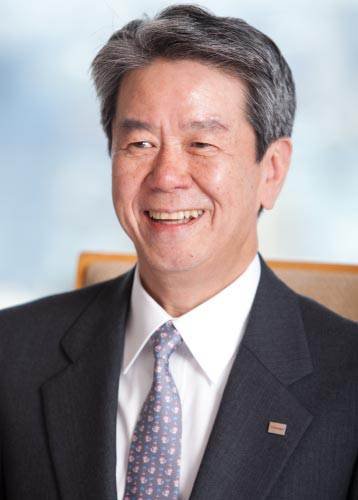Tracing its origins all the way to 1875, to companies founded by two giants of Japan’s modernization, Hisashige Tanaka and Ichisuke Fujioka, Toshiba has continually consolidated its reputation as a pioneer in the technologies of the day. That spirit of innovation still drives the company in all that it does.
The technology giant brought Japan its first radar, transistor television, and microwave oven; and the world its first laptop personal computer and NAND flash memory.

Today, Toshiba has grown into a global organization with more than 200,000 employees, 587 consolidated subsidiaries, and businesses in four main domains: digital products, electronic devices, social infrastructure, and home appliances.
“In the U.S., Toshiba is known for its consumer products like the TV or PC. But actually, we are more than that. We play a leading role in the American electronics industry and enjoy market leadership in NAND flash memory and storage products, and in HDDs and SSDs (technologies that support data intensive applications on mobile equipment and provide the core infrastructure for managing big data,” explained Hisao Tanaka, the recently appointed president and CEO of Toshiba.
“We are also active in public infrastructure in North America. In fact, we have been the leading supplier of thermal power steam turbines for nine consecutive years,” Tanaka added.
And in the field of medical equipment, Toshiba has developed life-saving products in collaboration with the Johns Hopkins University School of Medicine, one of its many partners. It currently has the third-largest market share in the world in computerized tomography (CT) and ultrasound diagnostic systems.
A deep American connection
One milestone in Toshiba’s history came in 1905 when General Electric (now GE) secured a stake in Tanaka Engineering Works, one of the original founding companies that later formed Toshiba. The partnership resulted in a sharing of technology that accelerated the development of several consumer products.

Today, Toshiba Group in North America consists of seventy-two consolidated subsidiaries with about 22,000 employees, including those from Westinghouse Electric Corporation and Vital Image, which joined the group in 2006 and 2011, respectively. Last year, Toshiba brought IBM’s retail solutions business into the group.The Japanese conglomerate entered the American market nearly fifty years ago with the establishment of Toshiba America in 1965.
In recent years, Toshiba America has rapidly evolved by focusing on growth businesses, developing new business areas, and shifting its portfolio towards business–to–business (B2B) operations. With that move, the group has strengthened its profit-making base.
“We are very much committed to the U.S. and we do make a contribution in various business areas. An example is our facility in Houston where we manufacture high-performance drive motors for Ford Motor Company’s hybrid vehicles,” Tanaka said.
Mindful of its responsibility to local communities and mission to help build a sustainable society, Toshiba partnered with the National Science Teachers Association to set up the ExploraVision Awards, a science–and–technology competition open to all K-12 students in the United States and Canada.
Guided by a teacher-sponsor, participants study a technology of interest, predict what that technology might be like twenty years from now, and explore what is necessary to make their visions a reality. Since its inception in 1992, more than 315,000 students have participated in ExploraVision.
This year, three student winners showcased their projects at the White House and met U.S. President Barack Obama.
Through this initiative, Toshiba hopes to inspire students to pursue a future in science, technology, engineering, and math. And with Tanaka at the helm, everybody can expect continuity in these social–development activities.
New leader, continuing vision
With the recent appointment of Tanaka as president, the Toshiba Group will benefit greatly from his long experience in the United States. But as a company veteran, he is also very familiar with Toshiba’s corporate philosophy and mission – “Committed to people, Committed to the Future.”
“The work of our founders still inspires us to meet our corporate social responsibilities by developing technologies, products, and systems that make life better; and to improve environmental management, so that we become one of the world’s foremost eco-companies,” said Tanaka. “With rising concerns about fast-growing population, increasing urbanization, and rising energy demand, Toshiba is dedicated to the wise use of the Earth’s finite resources by fully utilizing the technologies and knowhow accumulated over the years in its project to build “smart communities.”
Proving to be once more an innovator in this new field, Toshiba is taking part in thirty-five demonstration and commercial projects around the world to establish “smart communities” and the Japan-U.S. smart grid test project in New Mexico.
In February, Toshiba also joined the Clean Energy Demonstration Project in a major mall in Carmel, Indiana, which is demonstrating a plug-in ecosystem that integrates solar photovoltaic power generation with a vehicle-charging and battery-storage system.
“My management policy will focus on seeking growth in sales and revenue while maintaining a constant level of profit. I will also emphasize innovation, not only in products but in processes, too. And, of course, CSR and environmental activities will continue to be important, as we will fully leverage our technological prowess and leading edge product capabilities to offer people around the world a better future,” Tanaka said.
– This Special Report on Japan originally appeared in the July/August 2013 edition of Foreign Affairs (Credit: Janine Ramirez)

